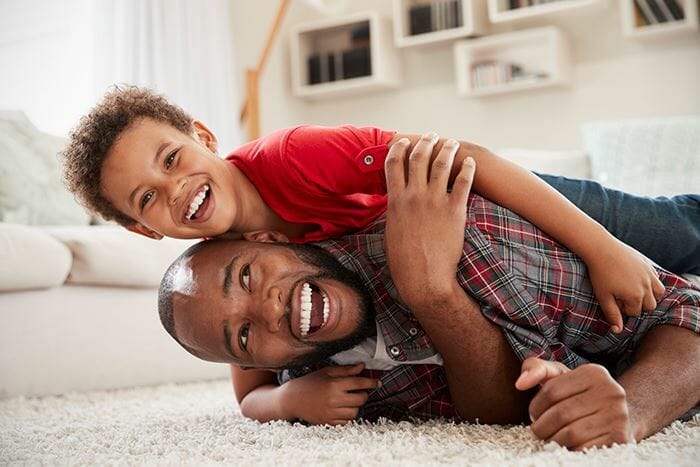Why Roughhousing is Actually Good for Kids

Is roughhousing safe and should it be allowed by parents? Actually, yes. Rough-and-tumble play has a variety of developmental benefits. But there’s a right and wrong type of roughhousing. Here’s an in-depth look at the benefits of roughhousing as well as tips to help kids stay safe.
Contents
Six Benefits to Roughhouse Play
1. Helps Improve Physical Fitness
Running, wrestling and rolling around with siblings or friends is a great source of exercise. Aside from building body strength, active play helps develop motor control, flexibility and overall coordination. Additionally, studies show kids who are physically active have a greater chance of staying fit as adults.
2. Helps Increase Intelligence
Wrestling with others causes brains to release a chemical called brain-derived neurotrophic factor (BDNF). This chemical stimulates growth throughout the cortex and hippocampus regions. It helps boost memory, language and logic.
3. Helps with Emotional Development
Play fighting helps kids learn to read the emotions of others. Is he going to try to grab me? How and where? What type of response is appropriate? Learning to read moods and navigate emotions is a skill necessary in practically all aspects of adult life. Interestingly, pretending to fight at a young age helps teach the responsible way to avoid fighting as adults.
4. Improves Overall Likeability
Kids who roughhouse tend to have an easier time maintaining friendships. Boys especially use physical play as a way to non-verbally bond. Young boys will only pretend-fight with others they feel comfortable around, like friends or friends-in-the-making.
Plus, roughhousing helps kids learn the difference between pretend play and real aggression. This helps teach social and problem-solving skills. Real aggression in others can be recognized early and ideally diffused before a physical altercation occurs.
5. Helps Develop Ethics and Morals
Picture an animal like a dog or a wolf playing with its pups. The parent, although larger and stronger, holds back so the young animal can win the “fight.” Human parents and siblings do this, too.
Called self-handicapping, this type of play teaches little ones a few different lessons. First, it demonstrates fairness and self-control. Also, self-handicapping helps improve the confidence of the smaller person (or animal). Finally, this type of play shows kids that winning isn’t everything.
6. Helps Increase Happiness
Humans are designed to thrive when our minds and bodies are engaged. Roughhousing is both a physical activity and a mental challenge. Neuroscientific studies have repeatedly shown this type of physical and mental stimulation provides plenty of joy.
Tips for Safe, Injury-Free Play
Of course, roughhousing doesn’t mean free-for-all. As a parent, you want to set some limits on what type of play is allowed. Generally, when you start to worry someone might be hurt, that’s the time to step in and slow things down.
Try not to let noise and exuberance cloud your judgment. Kids are often pretty loud when they’re running around and getting physical. That doesn’t necessarily mean they’re acting unsafely.
When it’s time to intervene, do so calmly. Yelling from a distance is likely to only add to the overall excitement felt by the child. If the children are getting a bit out-of-control, but aren’t quite doing anything wrong, there’s usually no need to chastise.
Instead, approach the children calmly and with a positive attitude. Say something like, “It sure looks like you two are having lots of fun, but let’s make a few changes.” Try to be as specific as possible about what needs to change (“Let’s throw these stuffed animals instead of these blocks” or “Make sure you’re not shoving enough to actually knock the other person down.”)
Also, create a designated area for rough play. Backyards, basements and playrooms are usually free from obstacles. When you have kids, rough play will almost certainly occur, at least from time to time. If you don’t have a designated area, that type of play might break out in the living room, which can easily damage your furniture.
When playtime is over, try to slowly calm the child down and ease back into normalcy. Don’t be surprised if the child cries a bit when roughhousing time is over. Little ones can build up a lot of emotions after “running wild” for a while.
Roughhousing actually plays an important role in childhood development. As long as you set some ground rules and provide supervision, rowdy activities can remain safe and injury-free. Encourage active play today and the benefits for your kids can last a lifetime!
